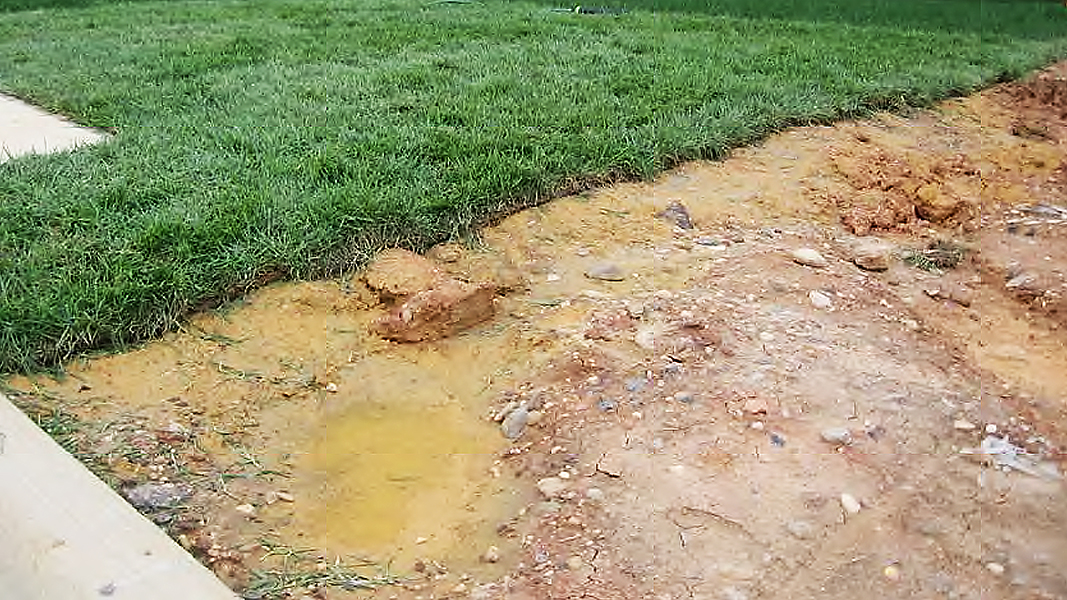Top: Disturbed soil photo courtesy Stuart Schwartz, Center for Urban Environmental Research and Education, University of Maryland Baltimore County
Craig Coker
Requiring minimum amounts of organic matter in soils following construction is not new. The Puget Sound “Soils for Salmon” program started in Washington State in 1999. Its mission was to promote simple best practices for developers that would rebuild soil health — protecting native soil where possible and restoring construction-disturbed soils with compost amendment. Organic-amended soils sustain plant life, filter and retain water, trap metals and nutrients and biodegrade contaminants, and ultimately reduce the quantity of chemicals and water applied for landscaping purposes.
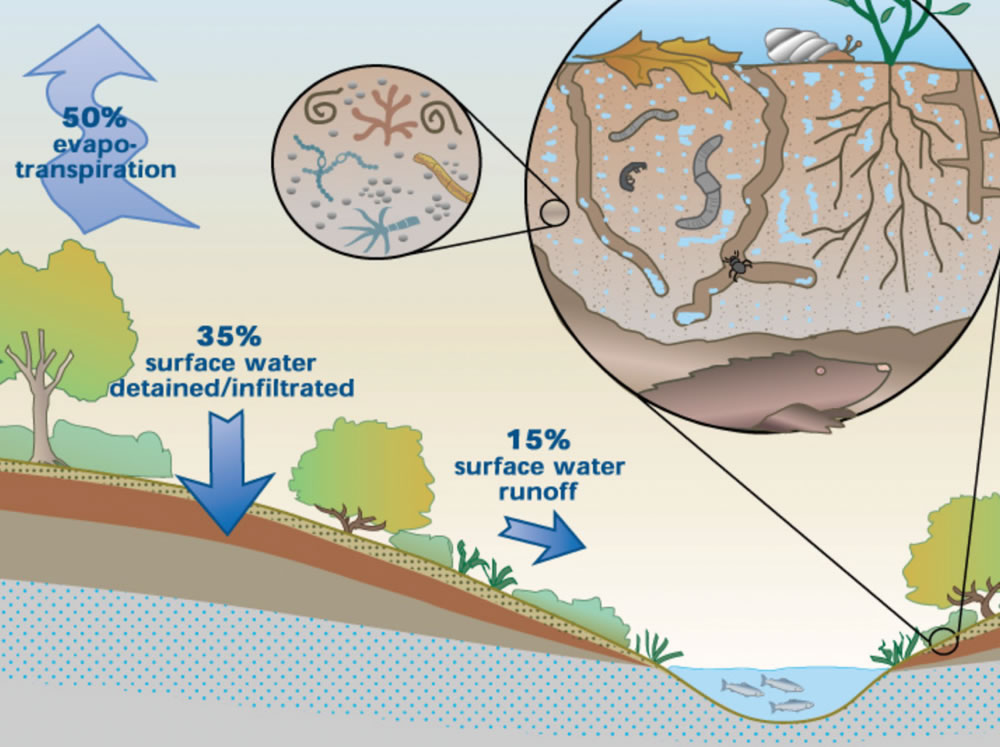 A year earlier in 1998, Fort Collins, Colorado adopted a land use code requiring use of compost at new building and development sites; the rule was adopted in the municipal code in 2003. The ordinance requires building permit holders to incorporate soil amendments into at least 6 inches of soil in any turfed or landscaped area, at a minimum rate of 3 cubic yards (cy)/1,000 square feet (sq. ft.) of area to be planted (Cernansky, 2014).
A year earlier in 1998, Fort Collins, Colorado adopted a land use code requiring use of compost at new building and development sites; the rule was adopted in the municipal code in 2003. The ordinance requires building permit holders to incorporate soil amendments into at least 6 inches of soil in any turfed or landscaped area, at a minimum rate of 3 cubic yards (cy)/1,000 square feet (sq. ft.) of area to be planted (Cernansky, 2014).
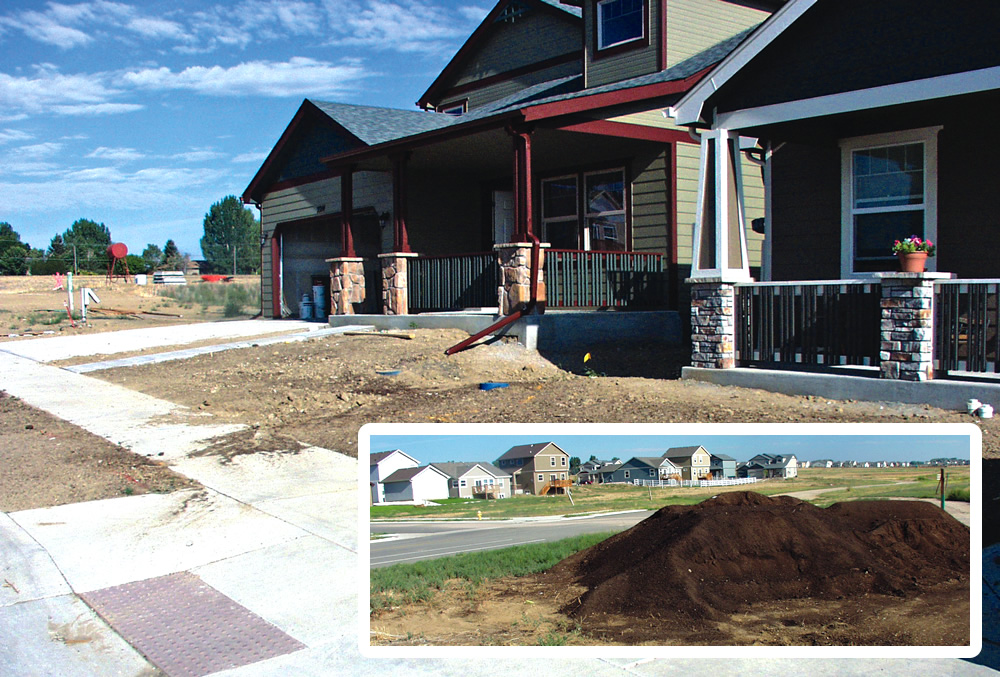
Fort Collins, Colorado adopted a land use code in 1998 requiring use of compost at new building and development sites, and expanded the rule to the municipal code in 2003. Use of compost (inset) is illustrated at a new construction site in the city. Photos courtesy of City of Ft. Collins
Addressing Water Supplies
While the primary driver behind the Soils for Salmon program was to improve the water quality in the Puget Sound to counter the threatened status of the Chinook salmon, in most western states, the concern has been over adequate water supplies, as about half the water directed to urban areas is used on irrigated landscapes. That was what led the City of Napa, California to offer a “Cash for Grass” program in response to California’s 2009 Water Conservation Act. The City offers water customers an incentive to replace their water-thirsty lawns with water-efficient landscaping. The basic program offers $1.00/sq. ft. to replace eligible lawn areas with low-water-use, climate-appropriate plants (covering at least 50% of converted area once fully grown), and permeable hardscape not exceeding 50% of converted area (Goldstein, 2012).
The Board of Water Commissioners of the City of Denver, Colorado adopted its Soil Amendment Program in 2008. Under Operating Rule 14.02.4 Soil Amendment for Irrigation of Turf at Newly Licensed Premises, proof of proper soil preparation is required before installation of plant material. Penalties may apply if soil amendment is not completed prior to the installation of plant material. Proper soil amendment is the equivalent of adding approved compost at a rate of 4 cy/1,000 sq. ft. of permeable area, incorporated (rototilled) to a depth of 6 inches (Platt, 2016). Adding one percent of organic matter to the top 6 inches of soil can increase soil’s water retention capacity to 27,000 gallons/acre (USDA/NRCS, 2013).
In 2015, California updated its 2010 Model Water Efficient Landscape Ordinance (MWELO), which directs cities and counties to ensure MWELO compliance on development projects with landscaped areas of 500 sq. ft. or more. This applies to residential, commercial, industrial and institutional projects that require a permit, plan check, or design review. Two components of the MWELO require use of compost to add soil organic matter:
- 23 CCR § 492.6. Landscape Design Plan (C): For landscape installations, compost at a rate of a minimum of 4 cy/1,000 sq. ft. of permeable area shall be incorporated to a depth of 6 inches into the soil. Soils with greater than 6% organic matter in the top 6 inches of soil are exempt from adding compost and tilling.
- 23 CCR § 492.11. Landscape and Irrigation Maintenance Schedule (b): A regular maintenance schedule shall include, but not be limited to, routine inspection; auditing, adjustment and repair of the irrigation system and its components; aerating and de-thatching turf areas; topdressing with compost, replenishing mulch; fertilizing; pruning; weeding in all landscape areas, and removing obstructions to emission devices.
While the California MWELO program has been “on the books” for a while, there has been a slower response from local governments to adopt the ordinance and to promote the program through public outreach and education. San Diego County published its Water Efficient Landscape Design Manual in June 2020 that incorporates the requirements of the County’s Water Conservation in Landscaping regulations with landscape design guidelines and installation specifications (see Additional Readings below).
Water Quality Improvements
In eastern states, the driver behind soil organic matter additions is storm water runoff quality improvements. The 4,479 square mile watershed of the Chesapeake Bay in Maryland and Virginia is a case in point. In 2015, the Chesapeake Bay Program convened a panel of experts to develop new Best Management Practices to separate storm water runoff from impervious areas from urban storm water drainage systems. One practice they recommended be adopted was to amend soils with poor infiltration rates (those in Hydrologic Soil Groups C and D) with compost.
Arlington County, Virginia is a densely developed suburb of Washington D.C. where around 200 individual one-story ramblers built in the 1950s and 1960s are torn down and replaced with larger, multi-story homes every year. This rebuilding process compacts the soils around the replacement homes, which leads to greater amounts of storm water runoff, with attendant impacts on the water quality-impaired Chesapeake Bay.
Soil Profile Rebuilding video (source Arlington County, VA)
The County issues Land Disturbing Activity permits for these residential rebuilds and after September 2021 will require permittees to have more rigorous storm water runoff controls. All permittees will be required to decompact their soils and use soil amendments to restore essential soil functions to absorb rainfall and runoff and support grass, tree, and other plant growth. They will be required to follow the procedures of Soil Profile Rebuilding (SPR) developed by Virginia Tech (see “Soil Profile Rebuilding Using Compost”).
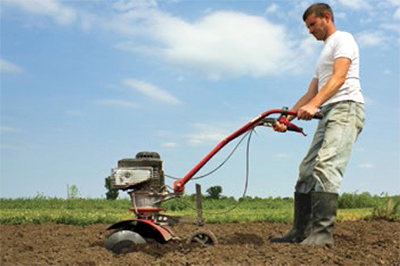
A rototiller can be used to incorporate compost 6 to 10 inches below the surface. Photos sourced from Fairfax County, VA
Arlington County’s western neighbor, Fairfax County, amended its Municipal Separate Storm Sewer (MS4) Permit program to include a Compost Soil Amendment option (see Additional Readings below for link). The size and depth of a soil compost amendment is dictated by the volume of storm water that the amendment proposes to manage, the current condition of the soil and the tools available to mix the compost into the soil below the surface. A soil compost amendment should have a minimum of 2 to 4 inches of compost incorporated 6 to 10 inches below the surface. This can be accomplished using a rototiller.
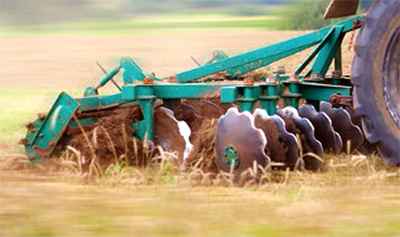
A subsoiler incorporates 6 to 10 inches of compost to a depth of 18 to 24 inches.
In order to amend the compost deeper into the soil, a subsoiler can be used. A subsoiler incorporates 6 to 10 inches of compost to a depth of 18 to 24 inches. Though not considered a soil compost amendment, a compost blanket is an option to add nutrients and organic matter to the soil in lieu of fertilizer.
Soil compost amendments are not recommended where:
- Existing soils have high infiltration rates
- The water table or bedrock is located within 1.5 feet of the soil surface
- Slope exceeds 10% percent
In order to ensure the success of soil compost amendments, Fairfax County recommends the following tasks should be undertaken in the first year:
- For the first six months, the site should be inspected at least once after each major storm event (half-inch of rainfall or more)
- Reseed amended soils that are bare or eroding and stabilize with vegetation
- Water once every three days for the first month, and then weekly during the first year (April through October) depending on rainfall
There are no major long-term maintenance needs associated with soil compost amendments, although the County encourages owners to dethatch the turf every few years to increase permeability. Fairfax County’s 2020 MS4 report indicated there were 17 Compost Soil Amendment projects owned or operated by the County.
Craig Coker is a Senior Editor at BioCycle CONNECT and a Principal in the firm Coker Composting & Consulting, near Roanoke, VA.


